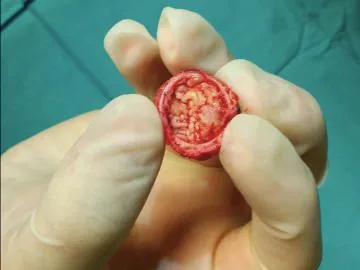Obstructive shock secondary to fungal prosthetic aortic valve endocarditis
2018-06-06EmilioRodriguezRuizDiegoIglesiasAlvarezCarlosPeGil
Emilio Rodriguez-Ruiz, Diego Iglesias-Alvarez, Carlos Peña-Gil
1 Intensive Care Medicine Department, University Clinical Hospital of Santiago de Compostela. Santiago de Compostela,Galicia, Spain
2 Cardiology Department, University Clinical Hospital of Santiago de Compostela. Santiago de Compostela, Galicia, Spain
Dear editor,
Fungal endocarditis is a rare disease with a poor prognosis, suboptimal diagnostic tools responsible for long diagnostic delays in most cases, and poorly defined activity of most antifungal agents in endocarditis.[1]The burden of diagnosis still lies with clinicians: they need a high index of suspicion the entity by understanding the organisms and the patients who are likely to be infected.[2,3]We present an exceptional case with obstruction of the left ventricle out fl ow tract (LVOT) causing sudden cardiac arrest.
CASE
A 83-year-old woman presented to the emergency department with dyspnea. She had a history of severe aortic stenosis, for which an aortic valve replacement was performed six months earlier, complicated with mediastinitis by Serratia marcescens. During the initial evaluation, she suffered from cardiac arrest, requiring advanced CPR maneuvers. The initial rhythm was pulseless electrical activity; after 5 minutes, the patient recovered spontaneous circulation in sinus rhythm with first degree atrioventricular block. Subsequent monitorization showed greater degree paroxysmal A-V blocks. Transthoracic echocardiogram revealed elevated aortic transvalvular gradients (Figure 1) and thickening of the bioprosthesis with a mass adhered, compromising its opening (Figure 2). Suspecting prosthetic valve endocarditis we contacted Cardiac Surgery for emerging intervention. The patient underwent excision of the mass and aortic valve replacement under cardiopulmonary bypass. Surgical samples and blood cultures were positive for Candida albicans (Figure 3). Postoperatively the patient developed septic shock with multiple organ failure and died on the second day after surgery.

Figure 1. Aortic transvalvular gradients (254×190 mm, 72×72 DPI).

Figure 2. Image of a mass adhered to the bioprosthesis (254×190 mm,72×72 DPI).

Figure 3. Surgical piece-fungal vegetation (254×190 mm, 72×72 DPI).
DISCUSSION
Fungal endocarditis is a serious entity that does not admit delay in diagnosis or treatment; Candida is the most common causative agent.[1,2]Among population at greatest risk; prosthetic valve carriers, central venous catheter and previous use of broad-spectrum antibiotics should be highlighted.[3]It is mandatory to always have in mind the possibility of infective endocarditis, as any delay could have fatal consequences, and the presentation can be highly non-specific with a broad spectrum of severity. The uniqueness of our case lies in its atypical presentation as cardiorespiratory arrest secondary to a probable obstruction of the left ventricle outflow tract.In prosthetic valve carriers minimal clinical suspicion should lead to prompt echocardiography in order to rule out any complication, since prosthetic valvular dysfunction could be lethal. Our case emphasizes the importance of clinical awareness and early recognition.
Funding:None.
Ethical approval:Not needed.
Conflicts of interest:No any benefits have been received from a commercial party related directly or indirectly to the study.
Contributors:ERR proposed the study and wrote the first draft.All authors read and approved the final version of the paper.
1 Cornely OA, Bassetti M, Calandra T, Garbino J, Kullberg BJ,Lortholary O, et al. ESCMID**This guideline was presented in part at ECCMID 2011. European Society for Clinical Microbiology and Infectious Diseases. guideline for the diagnosis and management of Candida diseases 2012: nonneutropenic adult patients. New Microbes and New Infections.European Society of Clinical Microbiology and Infectious Diseases; 2014;18(S7):19-37.
2 Baddley JW, Benjamin DK Jr., Patel M, Miró J, Athan E, Barsic B, et al. Candida infective endocarditis. Eur J Clin Microbiol Infect Dis. 2008;27(7):519-29.
3 Tattevin P, Revest M, Lefort A, Michelet C, Lortholary O.Fungal endocarditis: current challenges. International Journal of Antimicrobial Agents; 2014;44(4):290-4.
杂志排行
World journal of emergency medicine的其它文章
- Pre-recorded instructional audio vs. dispatchers’conversational assistance in telephone cardiopulmonary resuscitation: A randomized controlled simulation study
- The effect of wilderness and medical training on injury and altitude preparedness among backcountry hikers in Rocky Mountain National Park
- Emergency medicine residencies structure of trainees' administrative experience: A cross-sectional survey
- Assessment of toxicology knowledge in the fourth-year medical students: Three years of data
- Enoxaparin dosing errors in the emergency department
- Risk factors for ventilator-associated pneumonia in trauma patients: A descriptive analysis
